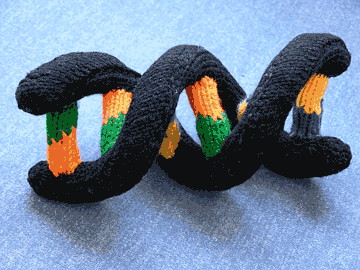BABY’S FIRST DNA MODEL

This is a knitted model of DNA, complete with GC/TA base pairs represented by orange-green bars with a pointed join and blue-yellow bars with a stepped join (because there weren’t enough stitches to make a wave or curve), replicating the standard simplified DNA model. As you can see from the picture, it also makes a good toy insofar as it holds its shape while squished or stretched, because it is stuffed firmly with cotton balls.
It was made with two equal black twisted tubes on size US 3 double-pointed needles (see the double-pointed needle tutorial and/or the tutorial on twisted tubes for more on how to make these). The stitch count for those was 18, or 6 per needle. The full stretched-out length of a black tube is about 13in/33cm, the natural relaxed coiled length is about 8in/20cm. The holes from dropping/adding stitches were woven through with more black yarn, as were any holes from increasing/decreasing at the ends.
The base pairs were 9 stitches around, or 3 per needle. The blue-yellow ones were one cast-on row of blue, then 5 rows of all blue, then as follows:
6th row: 2 yellow, 3 blue, 2 yellow, 2 blue
7th row: 3 yellow, 2 blue, 3 yellow, 1 blue
8th row: 4 yellow, 1 blue, 4 yellow
Then the 9th through 13th rows were all yellow, then a binding off row of yellow.
The orange-green ones were one cast-on row of orange, then 5 rows of orange, then as follows:
6th row: 1 green, 3 orange, 1 green, 3 orange, 1 green
7th row: 2 green, 1 orange, 3 green, 1 orange, 2 green
Then the 8th through 13th rows were all green, then a binding off row of green.
To put it all together, I held the two black coils side by side in a rough double-helix formation, then used three double-pointed needles jammed through at the middle and each end to hold the proper shape and distance. I pinned the first base pair just below the mid-point, then sewed it strongly into place using doubled-over black thread. Then I added the base pairs down that side to the end, then went up the other side, at each point ensuring that they were about the same distance apart and at roughly the same point on each black coil relative to where the coil’s woven lines were. As with real DNA, I varied the pattern of the base pairs, including reversing some of them.
Note that this model reflects a left handed helix, whereas DNA actually comes with a right-handed twist. The author is having a go at correcting this, and will hopefully one day have her solution available.